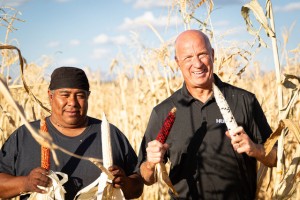December 8th is #NationalChristmasTreeDay. This of course sets up the great debate, real or fake? While every family weighs the pros and cons of choosing the Tannenbaum they rock around, a popular nation is that fake trees are more eco-friendly. After all, they can keep for many years, right? And isn’t it bad to cut down real trees merely for decoration? Not so fast. Americans purchase 10 million fake trees annually; 90% are made in, you guessed it, China. For those who track carbon footprints, compare what it takes to transport a tree halfway around the world (a total journey of 8,400 miles) vs. getting it from let’s say North Carolina, Oregon or Michigan. Yet the freighting of fake trees could fail in comparison to what it takes to make them: petroleum-based PVC plastics that are non-recyclable, which means after their normal life of 6 years, fake trees fill up landfills. And course, there is the forest management aspect. Just one fir can sequester one ton of carbon during its 6-to-10-year lifespan. Of the 350 million Christmas trees currently growing on US farms, only about 30 million are harvested each year. For every Christmas tree that is harvested, three new trees are planted. And the more real trees sold, the larger the incentive for farmers to increase the size of their carbon-sucking forests. There are 15,000 Christmas tree farms in the USA, employing over 100,000 people. And much like the story of the beef industry, Christmas trees are grown in areas that cannot support other crops. Plus, they are 100% recyclable, adding nutrients back into soils as mulch. Now none of this is to say that those opting for plastic trees will automatically be placed on the “Naughty List.” But real tree owners will find themselves in the good graces of Mother Nature.

Is this heaven? No, it’s Iowa… future home of USDA. This may be more than just a field of dreams if one Presidential candidate has his way. Over the weekend Ron DeSantis made that campaign promise. Politics aside, what a novel concept: placing the group in charge of farm policy to where the farms are.
Cover cropping may be the potluck of farming practices. There’s something for everyone, but the plates seldom look the same. That’s a conclusion one could draw from the recently released SARE national cover crop survey. Between 50-60% of all users strongly agreed that cover crops met their goals of improving water filtration, soil organic matter or carbon sequestration and attracting beneficial insects; 60-70% of all users strongly agreed that cover crops met their goals of improving soil health, reducing erosion and environmental stewardship. Opinions were more mixed when it comes to helping manage crop inputs. Over half of cover crop users reported no fertilizer savings, 21% reported saving over $20/A in fertilizer costs for corn and 12% saved $6-10/A on fertilizer for soybeans. Just one-third strongly agreed that progress was made on insect/disease management, while 42% saved money on herbicide costs and 3 out of 4 of all users admitted having better weed control. The top goal of farmers employing cover crops is to improve soil health (95%) followed by adding organic matter/sequester carbon (91%).

Big Green has been rolling in green lately. John Deere just posted record earnings for the third consecutive year, generating $52.5 billion in net sales and revenue for the year ending October 2023. That’s a 16% growth over last year. But on Wall Street, it’s not what you’ve done for me lately, it’s what you’ll do for me tomorrow. While Deere easily surpassed its 2023 earnings forecast, stock prices took a tumble during the announcement amid concerns over a softening demand for equipment. Most notably, sales of production and precision agriculture equipment are expected to drop 15-20% in 2024. High interest rates seldom bid well for machinery sales.
As we celebrate #WorldSoilDay on December 5th, let’s be mindful of the famous words from Paul Harvey, “Despite all our accomplishments, we owe our existence to a six-inch layer of topsoil and the fact it rains.” When your name is Huma, every day is world soil day.
Related Posts

This Week in Ag #42
What’s fueling regenerative agriculture? Sustainability, climate concerns, ESG-driven investors, soil health and heightened crop input costs are all major contributors. Another may be the shift in demographics. Millennials (born 1981-1996) recently passed baby boomers as the USAs most populous generation. And more than half of the US population is now comprised of millennials or younger. With a shift in population, and shift in culture, comes a shift in buying patterns.

This Week in Ag #41
This is American agriculture’s big week – Thanksgiving! Our celebration of food takes center stage on family dining tables from sea to shining sea. Not only do we honor the 1% who currently feed us, we also reflect upon the many contributions of the original American agriculturalists, our Native Americans. For starters, they saved the Pilgrims from starvation during their first years in the New World. The Wamponoag tribe utilized their famous “Three Sisters” cropping practice: corn, beans and squash.

This Week in Ag #40
I’ll never forget the sage words an old farmer told me when I announced my intention to start farming in the late 1990s. I explained that I was not leaving my marketing job and that I was also doing a fair amount of freelance consulting work. He told me, “It’s funny how many other jobs you need

